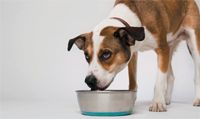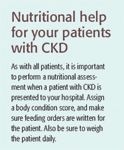Managing chronic kidney disease: Nutrition is key
A look at the effects of CKD and how proper nutrition can help.
Chronic kidney disease (CKD) is the most common renal disease affecting dogs and cats, especially older animals. Its causes are varied and include trauma, toxins, genetic anomalies, hypertension, ischemia, infections, immunologic diseases, neoplasia, and idiopathic interstitial nephritis. Since there is no single cause of CKD and the cause is often unknown, there is no definitive protocol for preventing it at this time.

By the time pets with CKD exhibit increased thirst and other signs of disease, their kidneys are already only functioning at 15 to 30 percent of capacity. (Comstock Images/Getty Images)
To manage patients with renal failure, proper nutrition is critical. Animals with CKD often become inappetent and are unable or unwilling to consume a sufficient amount of calories. A deficiency in calories and essential amino acids increases catabolism of muscle and other body proteins (e.g. albumin, immunoglobulins). Starvation is a serious concern when treating patients with this disease.
Dietary management may slow the progression of CKD, although there is some controversy as to when dietary intervention should be initiated and what diet to give. But once a patient is showing signs of uremia, it is a generally accepted practice to decrease the patient's phosphorus and protein intake to alleviate clinical signs. Following is a closer look at the effects of CKD and how proper nutrition can help.
Role of the kidneys
Kidneys remove wastes from blood that are produced from the breakdown of food, old cells, toxins or poisons, and many drugs given to treat other diseases. The wastes are removed with water as urine. The waste products measured in the blood include creatinine and urea nitrogen, but many other waste products are not measured by blood tests. The kidneys also regulate the amount of water in the blood by excreting extra water and retaining water to prevent dehydration by varying the amount of urine that is produced. In addition, the kidneys help regulate blood pressure by saving or eliminating sodium.
Complications of CKD
The percentage of dogs and cats with CKD increases with advancing age. In fact, it is one of the leading causes of death in older cats and dogs. Aging kidneys experience functional changes including a decreased glomerular filtration rate, decreased renal blood flow, and decreased urine concentrating ability. Structural changes, including kidney size and appearance, occur as well.

Nutritional help for your patients with CKD
The kidneys' ability to perform normal regulatory and excretory functions decreases over time as the nephrons (the functional unit of the kidney) die, resulting in azotemia. This loss of function is irreversible. Sometimes this decrease in function takes months to be recognized. Generally, by the time clinical signs (e.g. drinking too much, urinating in large volumes, leaking urine, vomiting, diarrhea, decreased appetite, weight loss, depression, weakness) are noted, the animal's kidneys are functioning at only 15 to 30 percent of capacity. This can cause complications including the following conditions.
Azotemia
Azotemia is defined as an abnormally high concentration of urea, creatinine, and other nitrogenous substances in the blood. Diagnosis is based on laboratory findings. There are many causes of azotemia, such as increased production of nitrogen-containing substances as with high-protein diets, gastrointestinal bleeding, or improper filtration by the kidneys. In patients with CKD, increased blood urea nitrogen (BUN) and creatinine concentrations occur because of diminished elimination by a kidney. Evidence of azotemia may not appear until later stages of the disease.
Uremia
The term uremia is used when azotemia is associated with metabolic and physiologic changes. Uremia occurs when both kidneys are functioning at only 75 percent of capacity. Clinical signs include vomiting, nausea, anorexia, dehydration, seizures, oral ulcers, ammonia-tinged breath, and coma.
Hyperphosphatemia
Phosphorus is an essential mineral in the body that is required for cells to function normally. The kidneys help regulate the phosphorus concentration in the blood. When kidney function is impaired, the glomerular filtration rate declines and leads to a decreased ability to excrete phosphorus, and the patient will eventually become hyperphosphatemic. Phosphorus and calcium are controlled by a hormone called parathyroid hormone (PTH). As the kidneys fail, the amount of PTH in the body is elevated. PTH draws calcium and phosphorus from the bones.
When the kidneys are only able to function at 20 percent of capacity, even typical concentrations of phosphorus in the diet can lead to hyperphosphatemia. The most serious side effect of hyperphosphatemia is the calcification of soft tissue, usually a kidney. The kidneys are so efficient at removing excess phosphorus that hyperphosphatemia is usually only found in patients with impaired renal function.
Dehydration
Increased water intake and increased urination are the first signs of CKD that pet owners are likely to notice. The body's ability to concentrate the urine decreases as the disease progresses. Although the animal is drinking more in an attempt to compensate for the increased urination, maintaining a balance will eventually become impossible, and dehydration will result. Dehydration not only means loss of fluids but also a loss of electrolytes. Clinical signs may include lethargy, muscle wasting, and generalized weakness. These may be a sign of hypokalemia, hypomagnesemia, or hypocalcemia.
Metabolic acidosis and anemia
Muscle weakness may be caused by metabolic acidosis, a condition resulting from CKD that disrupts the body's acid-base balance. Anemia also causes weakness in patients with CKD. The kidneys produce the hormone erythropoietin, and erythropoietin stimulates the bone marrow to make red blood cells. In patients with this disease, the kidneys are no longer able to produce enough of the hormone and a nonregenerative anemia results.
Loss of appetite
Not surprisingly, a loss of appetite is common in patients with CKD. Possible causes include dehydration, metabolic acidosis, anemia, and oral ulcers. Animals can display signs of nausea, such as vomiting, hypersalivation, lip smacking, or teeth grinding. Sniffing, licking, or looking at food and then turning away or trying to bury the food can be signs of a learned food aversion. A learned food aversion occurs when a pet becomes ill after eating and begins to associate feelings of nausea with eating. Overcoming a food aversion can be an arduous process. Antiemetic or prokinetic medication is often necessary to help a patient regain its appetite.
Therapeutic diets
Feeding patients with CKD a therapeutic diet containing a lower quantity of a high-quality protein and reduced phosphorus concentrations may prolong their survival time, decrease uremic episodes, and slow the disease progression. Right now, no commercial pet foods are phosphorus-restricted—only veterinary therapeutic renal diets are. In addition, no commercial pet foods come close to the reduced protein concentration in veterinary therapeutic diets. Therefore, it is important to explain to clients the importance of feeding the prescribed therapeutic diet to pets with CKD.
Feeding challenges
Often a hospitalized patient is unwilling to eat the new therapeutic diet even after clinical signs of nausea have resolved. If this problem continues throughout the pet's hospital stay, it is best to let the patient eat whatever it is willing to eat. However, send the patient home with samples of various therapeutic renal diets, so the owners can offer them in a more relaxed environment. If the pet is still unwilling to eat a therapeutic diet, the owner can mix the new food with the old food, adding more each day until the pet is eating only the therapeutic diet.
Long-term management
At discharge, recommend follow-up visits, especially for patients that are undernourished or borderline, and make sure that the owners understand what amount of food is appropriate for their pets. (Be sure to communicate the need for follow-up visits to receptionists so they can schedule the next appointment before the client leaves.) Since veterinary therapeutic renal diets feature decreased protein concentrations, their fat content is higher than most premium diets. The higher fat content adds to the diets' palatability but should be taken into account when animals present with concurrent disease processes that could be worsened by high fat intake.
Charlotte Higgins, AS, CVT, is a nurse practitioner in nutrition at the MJ Ryan Veterinary Hospital of the University of Pennsylvania in Philadelphia. She's also a charter member of the Academy of Veterinary Nutrition Technicians.